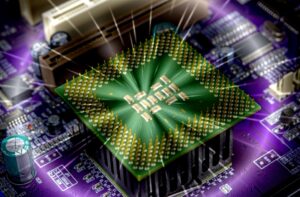Have you ever caught a car grille smiling at you, seen a grumpy face in your morning coffee foam, or spotted the Man in the Moon gazing down from the night sky? If so, you’re not alone, and you’re certainly not imagining things. You’re experiencing a fascinating and completely normal psychological phenomenon known as face pareidolia: the tendency to perceive human faces in inanimate objects and random patterns.
For a long time, this tendency was dismissed as a mere curiosity, a simple trick of the light. Some even once considered it a sign of mental illness. But a wave of recent scientific research has revealed a profound truth: seeing faces everywhere is not a bug in our cognitive software, but a fundamental feature. It’s a direct window into the ancient, hardwired programming that helped our species survive and thrive. Let’s explore the cutting-edge science that explains why your brain is a world-class face-finder.
Ancestral Echoes: The Evolutionary Advantage of a Face-Finding Brain
Your brain’s knack for spotting faces is an echo from a time when survival depended on rapid-fire perception. This ability is rooted in powerful evolutionary pressures that favored a brain that was hypersensitive to face-like patterns.
The primary driver is the “better safe than sorry” principle. For our ancestors navigating a world filled with predators and potential rivals, the cost of failing to detect a hidden threat (a false negative) was catastrophic. In contrast, the cost of momentarily mistaking a gnarled tree trunk for a lurking predator (a false positive) was negligible. As neuroscientist(https://www.sydney.edu.au/news-opinion/news/2021/07/07/man-in-moon-why-our-brains-see-human-faces-everywhere-face-pareidolia.html), “From an evolutionary perspective, it seems that the benefit of never missing a face far outweighs the errors where inanimate objects are seen as faces”. Our brains evolved to be over-sensitive, applying a crude template of “two eyes over a nose and mouth” to everything we see, ensuring we never miss a real face that matters.
But threat detection is only half the story. Famed astronomer(https://marinamunro.wordpress.com/2011/10/16/pareidolia/): we are hardwired from birth to recognize faces to ensure our survival through social connection. An infant who can quickly identify a human face is more likely to smile, engage, and win the hearts of its caregivers, securing the vital bond needed for protection and nourishment. Modern science strongly supports this, with studies showing that newborns, and even fetuses in the third trimester, preferentially look at face-like patterns over other shapes. This innate ability underscores that our brains come pre-loaded with face-detection software, a critical tool for our intensely social species.
The Neural Blueprint: How the Brain Constructs a Face from Nothing
So, if evolution wrote the code for face detection, how does the brain actually run the program? The answer lies in a specialized network of brain regions dedicated to processing faces, and the process happens faster than a blink of an eye.
The Brain’s Face Specialist: The Fusiform Face Area
Deep within your brain’s temporal lobe is a region known as the Fusiform Face Area (FFA). Neuroscientists, using functional magnetic resonance imaging (fMRI), have identified the FFA as the brain’s central hub for face perception. Damage to this area can lead to prosopagnosia, or “face blindness,” highlighting its critical role.
The most groundbreaking discovery for understanding pareidolia is that the FFA activates robustly not only when you look at a real human face, but also at the very moment you perceive an illusory face in an object. This proves that, on a neural level, your brain initially treats the face on your toast with the same seriousness as the face of a friend.
A Fleeting Illusion: The Two-Stage Process
This initial recognition is part of a sophisticated, two-stage process that happens in a fraction of a second.
- Stage 1: Rapid Detection. Using magnetoencephalography (MEG), which measures the timing of brain activity, scientists found that an illusory face triggers a response in the FFA at around 165 milliseconds—a speed nearly identical to that for processing a real face. Your brain automatically flags a potential face without conscious effort.
- Stage 2: Cognitive Verification. This “face” signal is fleeting. Almost immediately, other brain regions kick in to analyze the stimulus more carefully. Within just a quarter of a second (about 260 milliseconds), the brain’s representation shifts, and the object is correctly re-categorized as what it actually is—a purse, a pepper, or a plug socket. This explains the strange dual experience of seeing both a compelling face and an object at the same time.
The Predictive Brain: A “Top-Down” Process
Perhaps the most revolutionary insight comes from the work of Professor Kang Lee at the University of Toronto. He challenged the traditional “bottom-up” view of vision—where our eyes passively send data to our brain for analysis. Lee’s research provides powerful evidence for a “top-down” model, where the brain actively predicts and projects meaning onto the world.
In his experiments, when participants were led to expect a face in random visual static, their FFA lit up even when no face was present. This suggests that the frontal cortex, the brain’s executive center, sends a signal down to the visual cortex, telling it what to see. As Lee puts it, “Instead of the face imagery coming from the outside, the brain generates some kind of expectation from the frontal lobe… and then we see faces”.
The Individual Lens: A Mirror to the Mind
While the machinery of pareidolia is universal, our individual experiences of it can vary widely, reflecting our unique personalities and moods.
Studies have found a strong link between creativity and pareidolia. Creative individuals tend to see these illusory patterns more often and more quickly, leading some researchers to label it “divergent perception”—a perceptual parallel to the flexible, open-ended thinking that defines creativity.
Even more fascinating is that our brains don’t just see a face; they instantly analyze its “expression” and assign it social traits like gender and emotion. Research shows we are quicker to identify “happy” expressions on illusory faces we perceive as feminine and “angry” expressions on those we see as masculine, mirroring the same biases we apply to real human faces. This reveals that pareidolia triggers our entire social cognition toolkit, acting as a mirror that reflects our own internal, automatic biases.
A Feature, Not a Bug
The next time a piece of driftwood seems to gaze at you or an electrical outlet looks shocked, take a moment to appreciate what’s happening. You are not being irrational; you are witnessing a profound and ancient cognitive process in action.
Seeing faces in things is a testament to a brain exquisitely tuned for survival and social connection. It’s a beautiful demonstration of how our perception is not a passive photograph of the world but an active, creative construction, shaped by millions of years of evolution and our own unique mind. This remarkable phenomenon is a feature, not a bug—a sign that your brain is doing exactly what it was designed to do: find meaning, humanity, and connection in the world around you.












